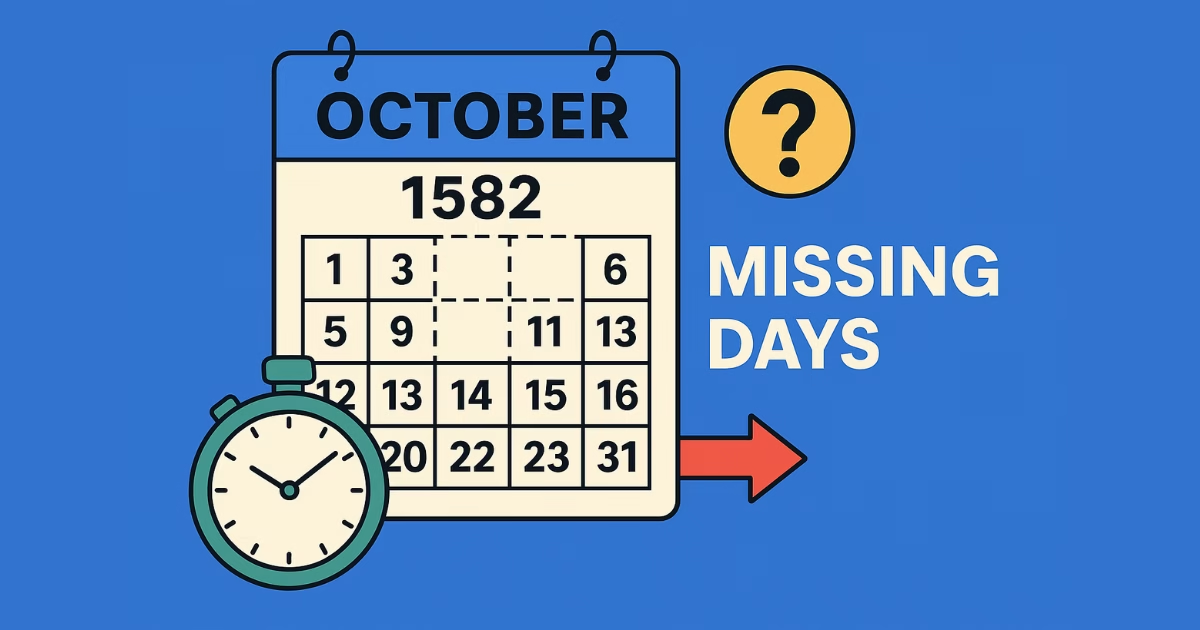Most people don’t think twice about the days on a calendar, but back in October 1582, something extraordinary happened. Known as the October 1582 missing days, this strange historical event left people confused, anxious, and even angry. Overnight, ten days simply vanished from the calendar. One day it was October 4, 1582, and the next morning, it was October 15, 1582.
Why did this happen? The answer lies in a centuries-old problem with the Julian calendar, which had slowly drifted away from the actual solar year. To fix the issue, Pope Gregory XIII introduced the Gregorian calendar, and the missing days were part of this historic reform.
In this article, we will explore the fascinating story of the October 1582 missing days, why they were necessary, and how they shaped the modern world.
The Story Behind October 1582 Missing Days
To understand the October 1582 missing days, we need to look back at the Julian calendar, introduced by Julius Caesar in 45 BCE. The Julian system was a big improvement over earlier calendars, but it wasn’t perfect. It assumed a year was exactly 365.25 days, adding a leap day every four years. However, the real solar year is about 365.2422 days — slightly shorter.
That tiny difference caused the calendar to drift by roughly one day every 128 years. Over the centuries, important dates like the spring equinox shifted earlier on the calendar. This was a big problem for the Church because Easter’s date depended on the equinox.
Pope Gregory XIII decided something had to be done. His solution was bold: introduce a new calendar system and remove the extra days that had piled up over centuries. This set the stage for one of history’s strangest time corrections.
Why 10 Days Were Skipped in October 1582
The main reason for the October 1582 missing days was to correct the shift in the calendar caused by the Julian system. By the 1500s, the calendar was out of sync with the seasons by about 10 days. The spring equinox, once on March 21, was falling on March 11. For the Catholic Church, this was a big issue because Easter’s date depended on the equinox.
To fix the problem, Pope Gregory XIII ordered that ten days be skipped. This meant that Thursday, October 4, 1582, was immediately followed by Friday, October 15, 1582. People went to bed on the 4th and woke up on the 15th. It wasn’t magic or a glitch — just a decision to realign time with nature. The change shocked people, but it was necessary to keep seasons and religious events in the right place.
Countries That Adopted the Change (and Those That Didn’t)
The October 1582 missing days were first seen in Catholic countries like Italy, Spain, Portugal, and Poland. These nations accepted the Pope’s authority and quickly adopted the Gregorian calendar. France and some Catholic German states also followed the reform without much delay.
However, Protestant and Orthodox countries were more skeptical. England, for example, didn’t adopt the Gregorian calendar until 1752 — almost 170 years later. Russia waited even longer, finally switching after the Bolshevik Revolution in 1918.
This led to some odd situations. For centuries, different parts of Europe were using different dates. Diplomats, merchants, and travelers often had to keep track of two calendars at once. It was a confusing period, but over time, most of the world adopted the Gregorian calendar because of its improved accuracy.
Impact of the Calendar Change on History
The October 1582 missing days had both immediate and long-term effects. Right away, people were confused. Some worried they had lost part of their lives. Workers feared they’d miss out on wages for those ten days. There were even protests in some places, though many stories of widespread riots are myths.
In the long run, the change brought stability. Seasons lined up with the calendar again, and Easter was celebrated on the correct date. It also improved navigation and astronomy, which relied on accurate calendars. Historians today have to carefully adjust dates from documents written during this period, especially when comparing events across countries using different calendars.
The calendar change showed just how powerful timekeeping is in society. Without fixing the drift, religious, social, and scientific life would have grown more chaotic.
Common Myths and Misunderstandings About the Missing Days
The October 1582 missing days sparked myths that still pop up today. One common story says that people believed they lost ten days of their lives and that they demanded those days back. Another myth claims that landlords charged tenants rent for the missing days, sparking widespread protests.
While it’s true that people were confused and uneasy, there’s little evidence of mass riots or economic collapse. Most people adjusted, though grumbling was common. Some also wrongly think that the whole world switched calendars in 1582, when in fact, many countries waited centuries.
The idea that people thought time was being “stolen” from them reflects a human fear of change, but the truth is, life went on — just with a slightly adjusted calendar.
Legacy of the October 1582 Missing Days Today
The October 1582 missing days left a lasting legacy. Today, most of the world uses the Gregorian calendar. The reform improved leap year rules by skipping leap years on most centuries (like 1700, 1800, 1900), except when the year is divisible by 400 (like 1600, 2000). This keeps the calendar aligned with Earth’s orbit.
Thanks to the reform, we now enjoy consistent seasons and holidays that match the solar year. Even though we rarely think about it, the work done in 1582 still shapes our daily lives.
Interestingly, some religious groups and communities still follow the old Julian calendar for traditional purposes. But for the most part, the Gregorian system rules. The missing days of October 1582 remind us that timekeeping is a human invention — and sometimes, humans have to fix it.
Also Read: 10 Inspirational Female Leaders Who Changed the World
Conclusion
The October 1582 missing days may sound like a strange historical footnote, but they were an important moment in the story of timekeeping. Pope Gregory XIII’s bold decision to skip ten days corrected centuries of drift and set the stage for the modern calendar we rely on today.
Though people were confused and even upset at first, the reform brought order to religious festivals, agricultural seasons, and scientific work. It also reminds us that even something as solid as time is shaped by human decisions.
As we look at our calendars today, few of us realize the drama behind the dates we use. But hidden in October 1582 is a fascinating chapter of human history — one where days disappeared, and the world kept turning.
FAQs about October 1582 Missing Days
Q1: Why did October 1582 lose 10 days?
The calendar was out of sync with the solar year by about 10 days, so Pope Gregory XIII ordered the days to be skipped to realign the calendar.
Q2: Which countries skipped the days in 1582?
Catholic countries like Italy, Spain, Portugal, and Poland skipped the days. Protestant and Orthodox countries adopted the change later.
Q3: Did people really think they lost part of their lives?
Some people were confused and worried, but there’s no strong evidence that they believed they lost years or demanded the days back.
Q4: When did England switch to the Gregorian calendar?
England and its colonies switched in 1752, skipping 11 days to catch up.
Q5: Does the Gregorian calendar still work today?
Yes — it’s used worldwide and keeps our seasons and holidays aligned with Earth’s orbit.

Hi, I’m Shafy Ali – a curious mind and passionate writer at Celiac Magazine. I cover a little bit of everything, from everyday tips and how-tos to deeper dives into topics that spark conversation. I enjoy turning research into readable, relatable content that informs and inspires. Whatever the subject, I aim to keep it clear, engaging, and genuinely useful.

